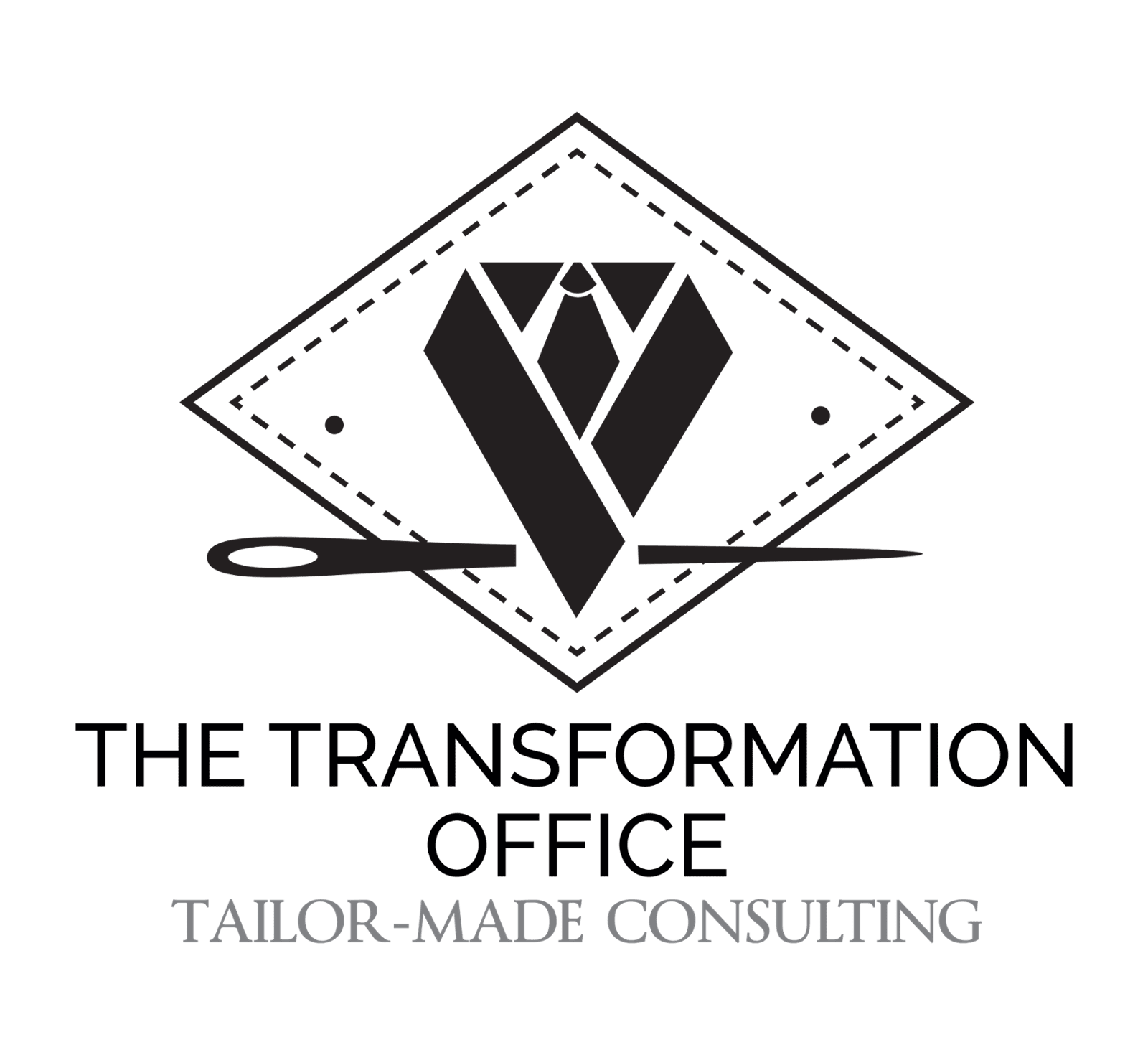
Written By: Jonathan Parnaby
Director / Owner of The Transformation Office
Foreword
Episode 1 - The Change Framework
"Blueprint to Success"
In the first episode of The Practical Change Manager I want to focus on Change Frameworks, the simple reason is that without a defined change framework it’s a bit like building a skyscraper without a solid blueprint, disaster.
Your first task as Change Manager is to define which framework the programme is going to adopt and there are plenty to choose from. The main reason for this is that every organisation, team and person is different so to have a one size fits all change framework is likely to fail. At The Transformation Office we've created our very own flexible Change Management Framework called ENGAGE™ which I’ll showcase throughout this series and provide practical examples / templates along the way. The visual below outlines the core concept of the framework.
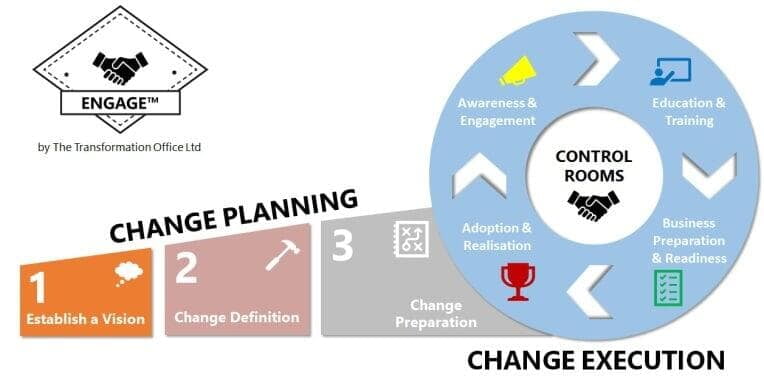
This framework is broken down into 2 main phases:
- Change Planning (Waterfall) – This is a very structured phase first establishing the foundations of what the change is all about, defining what the change is and means to the business and then assessing and preparing plans.
- Change Execution (Iterative) – This is a more fluid and iterative process by executing communications, training, organisational design, business readiness activities all linked together from a control room (more on those in a future episode).
Each phase has several related stages but rather than use a business example to bring these to life I’m going to use a personal one instead.
Step 1 – Establish & Vision
I remember last year me and my wife sat down and had a discussion that something in our lives had to change since we moved out of our town into a village, our daughter was still going to school in the town. The commute to take her to school took a 1 hour to get her there each trip (if we were lucky) and we had just had our son. Due to the proximity of our daughter’s school, it was extremely unlikely that our son would attend there so we had our catalyst for change with other tangible benefits (getting back 2 hours a day and saving ¼ tank of fuel per week).
Step 2 – Change Definition
We sat down and looked at the change impacts. How would this affect our daughter? How would this impact her friends? Will she fit in with the new environment? We carefully weighed up those change impacts and identified how we could address each one so we were prepared for when we spoke to her.
Step 3 – Change Preparation
At this stage, my daughter was completely unaware whilst we were assessing those change impacts. Once we looked over them we put in a draft plan together to get my daughter from being un-aware to being fully prepared. This included a variety of activities in Change Execution and started with when and how we were going to tell her the news.
Step 4 – Awareness & Engagement
It’s fair to say that we didn’t expect the announcements to go down well, so we had to think carefully about when to tell her. We sat her down on a Friday after school so she had the weekend to let the news sink in, and it was tough, there were tears, she didn’t want to lose her friends and begged us “not to make her move schools”. Because we planned, we had answers to her questions which helped her to come to terms with the changes. We had planned to have multiple sit downs with her and to highlight the benefits to her, e.g. shorter travel distances to school (she could walk or take her bike/scooter), more time in the morning without rushing to the car and best of all new friends in the village who she could see outside of school.
Step 5 – Education & Training
We decided to let her trial some of the changes early on for example “practice school runs on her bike” and go school dress shopping (they have different colour schemes). This helped her to visualise the changes and what it meant personally to her. She started to openly discuss the change with her friends at her local Rainbow Girl Guiding group and found out that some of them would be at her new school. The school itself had a trial morning so she could meet her class before she started.
Step 6 – Stakeholder Preparation
Now she was getting excited for the change and wanted to get prepared for her new school such as new stationery and book bags. We had a checklist of items which she had on the fridge so she could tick them off once each readiness item was complete (it doesn’t matter how old you are we all love ticking items off).
Step 7 – Adoption & Realisation
Then came the morning of her first day of her new school and I sat her down and asked if she was nervous and she replied: “No, I can’t wait to start school, I’ve already made 4 friends when I visited the other morning”.
In the next episode, I’ll be bringing to life the core foundation of any change approach which is capturing Change Impacts
Episode 2 - The Change Impacts
"It's more than understanding what the change is, it's about understanding what it means"
In the last episode, I discussed the importance of having a defined Change Framework as your blueprint to success. The Transformation Office have created our very own framework called ENGAGE™.
In this episode, I’m going to explore the first two stages of the ENGAGE™ framework but predominately Stage 2: Change Definition which is all about defining the change, most notably capturing change impacts.
Stage 1: Establish a Vision
Before any change impact can be captured from the business the Change Manager must completely understand what the changes are before any assessment is made, I know that sounds kind of obvious when you write it down but never the less it’s critical and sometimes forgotten. Before you even contact the business make sure that you spend time with the Business Analysts or Process Owners who have designed / documented the specific change in the first place. Remember these resources have usually been involved right at the beginning running requirements gathering workshops or TO BE Process workshops, if you have been lucky you may have been involved in those at the start as well which will give the change team a solid foundation to work from.
The vision should technically be facilitated by the Programme Manager and should be readily available for the Change Managers to use and understand. However sometimes this information doesn’t exist. In the past I’ve had to create these mainly to provide me and my team some steering and guidance when talking with the impacted employees. I like to think drafting the vision it is a bit like writing a story with a beginning, middle and end:
- Beginning: Why is the change happening? What is the driving force behind the change? What are the triggers?
- Middle: How will we transition the change? Multiple stepping stones or a big bang?
- End: What does the TO BE look like, what is our target position?
An effective way to capture this vision is through a Target Operating Model (TOM). I’m not covering the TOM process in detail in this series however the visual below highlights typical components of a Target Operating Model and how each component if mapped properly will provide an extremely useful insight for the Change Manager to help relay that vision to the business. My point here is to try to ask for this information before you start the change definition process to help save time, if it doesn’t exist then spend some time crafting a high-level vision statement so at least the Change Team are on the same page.
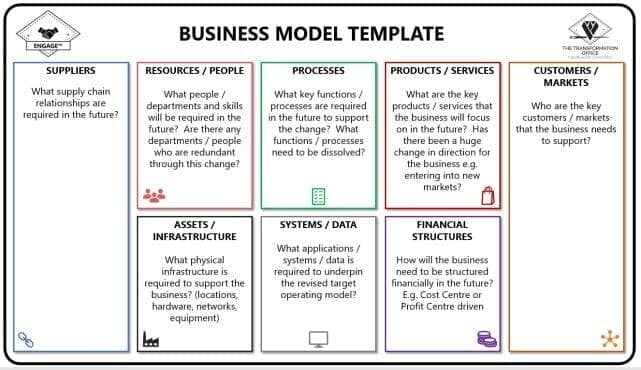
Stage 2: Change Definition
Great, you now understand the vision of what the business is trying to achieve which means you know what the change “is” but now it’s time to understand what the change “means” to individuals, teams and the organisation. This is understood by using a process of formally capturing change impacts. The definition of a change impact is “identifying the potential consequences of a change, or estimating what needs to be modified to accomplish a change”. Essentially, they are statements recorded to give the Change Team something tangible work from and to design effective change plans against. Without change impacts, the changes plans are likely to be a generic set of activities and not tailored to the specific groups which are unlikely to help the people even begin to go through the change curve.
Enough theory, let me break this down with a practical example:

Now we know what the change is we can set-up Change Impact Workshop(s) with the key stakeholders including the designers of the change and with some of the recommended business people who can provide a lens on what the changes mean to them. The outputs from these workshops is to formally record change impacts into a log, this information must contain enough variety so that you can analyse it to produce the Change Impact Assessment
So going back to the case study of Purchase Invoices the below is a rough guide on what type of information should be captured through this process:
- What project is enabling the change for this impact? If your project has multiple streams or you’re working across multiple projects, then having this will always link the change impact to the project which is driving the change
- What end to end process does this impact reside in? This would fall into the Procure to Pay (Procurement) process
- What functional division does this impact reside in? There are multiple functions such as Stores and Finance
- What stakeholders are impacted by this change? Using the case study likely candidates would be Finance – Accounts Payable, Store Managers, Store Administrators, Suppliers). Note: Ideally list out one change impact per impacted stakeholder group to aid analysis.
- When will this change impact the stakeholders? 6 months’ time – Note: This would likely be a date
- What is the change impact type? Out of the following impact types does this impact need to be managed before, during or after the cutover.
- Type 1 – Must be mitigated before go-live
- Type 2 – Must be mitigated during go-live
- Type 3 – Must be mitigated post go-live
- Type 4 – No dependency on go-live
- How many people in the organisation are impacted? 150 out of 1000 – This helps quantity the size of the impact and bandings can work well here.
- Who is accountable for making this change happen? The Finance Director (Sponsor)
- What is the benefit of the change to impacted stakeholders? Centralised managed of invoices freeing up Store Managers and Store Administrators time. Increased financial controls by having approvals done electronically at the front end of the procurement process.
- What are the likely barriers to change? Loss of control within stores, Finance teams to utilised increased technology hardware e.g. scanners
- What are the dependencies for enabling this change? New scanning solution and procurement module within ERP system.
- What engagement activities would help mitigate these impacts? Store Managers conference to highlight the new procurement solution ensuring change benefits and impacts are understood, targeted communications in local publications and intranet channels, training of the new procurement solution to include education around invoices and where they go. Adjustments to Finance AP clerks to include scanning duties. These would be broken down across the following categories to aid analysis (Stakeholder Engagement, Communications, Training, Org Design, Business Preparation)
I’ve recorded Change Impacts in a variety of formats in the past, from Excel Spreadsheets, SharePoint Lists and even bespoke cloud based systems. Below is an example of a spreadsheet Change Impact Log highlighting how the data can be structured to aid analysis in the next stage.
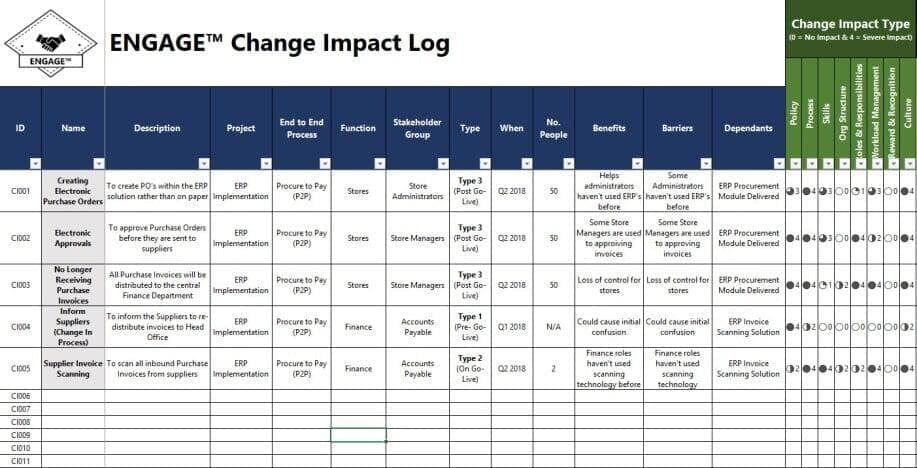
Next time I’ll be discussing how we convert the change impact data into a Change Impact Assessment and how these can be used to start to build awareness across the senior business stakeholders, more importantly sowing the seeds by creating your very own Change Network.
Episode 3 - Creating Change Impacts
"The key to unlocking your proactive change initiatives"
So, you’ve spent hours in workshops capturing many change impacts and you’ve been recording them successfully within the Change Impact Log. You look at the sheer volume of data and information with dread and the Programme Manager is asking you for your Change Plans so he can brief the exec team on how we’re going to get the business to adopt these changes.
Within the Change Framework we are now in Stage 3: Change Preparation, ideally, you should have captured everything you need to start analysing and building a series of practical activities but before we launch into a full-blown change plan we need to make sure that the Programme Team validates our understanding of what the changes mean. This is where we introduce the Change Impact Assessment.
Now the change impacts are captured, this is the time to review the impacts internally once again and to tag them with one (or more) of the following Change Impact Types:
- Policy – Changes in company policy which can affect internal / external operations within an organisation
- Process – Changes in the actual operation of a process by removing, amending or adding steps
- Skills – Changes in the required skills to operate the new ways of working
- Organisational Structure – Changes in the organisational structure & hierarchy such as reporting line changes, new hires or even brand new divisions
- Roles & Responsibilities – Changes in roles to formalise new tasks as part of their day job
- Workload Management – Changes to the volume of work which that department or person processes. E.g. has this been transferred somewhere else?
- Reward & Recognition – Changes in colleagues performance managements and KPI’s which could impact compensation / bonus
- Culture & Ways of Working – Changes in the organisations culture, challenging the “we have always done it like that” mentality.
The reason for tagging your impacts at this stage is you can group and analyse all the 8 impacts types through one of the many lens and analyse to see if the impacts make sense. Think about your change impacts being stored in a Rubiks Cube where you’re looking all around it, spinning rows & columns around until you get the picture you want (hopefully without giving up and throwing it in the bin at Christmas time, I definitely didn’t do that in the 80s!).
Using our case study example of implementing procurement changes into a retail organisation you may then ask “why do we only have policy related change impacts just against the Finance department and not the Stores Ops function?” This is when you are really assessing the change to make sure that any gaps are resolved and plugged. Once you’re happy with the change impact data then it’s time to present this information in a more accessible format. Please don’t think about sitting down with the business along with your Change Impact Log spreadsheet containing 600 lines and making them go through it, trust me I’ve been there and it wasn’t pretty, accessibility is key here and we need to make the information targeted.
So, going into the practical example, the below Change Impact Assessment structure is one that I’ve used and works well. First, you’ll need to decide how best you want to organise the assessment, it’s a good job we put all those filters in the change impact log.
- Group by Project – This could work for you if you are working in a large-scale programme which contains multiple projects delivering capability at similar times.
- Group by End to End Process – This could be useful if the programme is changing a lot of the end to end processes at similar times (e.g. Procure 2 Pay, Market 2 Cash, Hire 2 Retire)
- Group by Function – This could be helpful if you need to demonstrate the changes to a function, e.g. if you’re sat with the Sales Director then you can demonstrate the changes to his / her division.

Think about your audience and who is going to consume this information, you may need to build a few based on different viewpoints (e.g. the Programme Team may want the assessment by the project because their programme is implementing 10 projects however the business may want to see it by function). I’ll now break each section down with visual examples:
End State Summary – This section provides a holistic view of the all the high-level changes across your chosen grouped structure, in this case by function. This can be used as an executive summary to senior stakeholders to help explain what the core changes are:
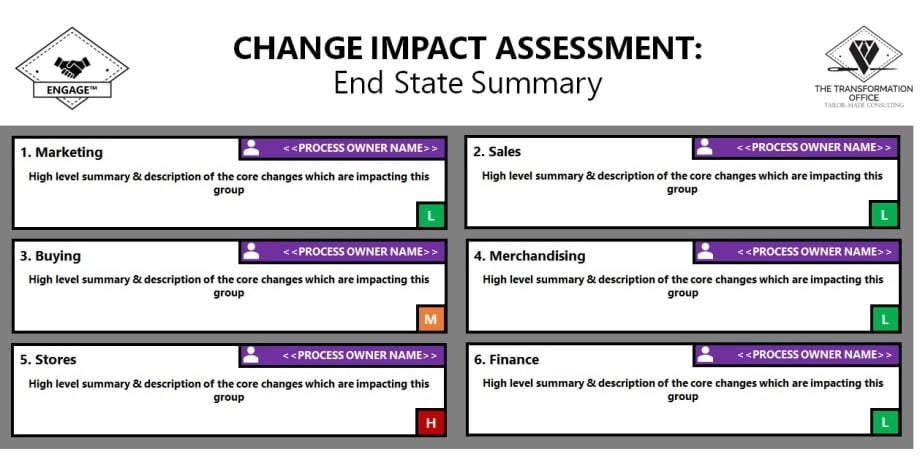
High-Level Overview – This is designed to explore a bit more information about the change and its impact for a group (e.g. Stores). The highlights are:
- Key Changes – These are the grouped together change impacts (remember accessibility is key)
- Timescales – Highlights when the expected changes are going to happen
- Business Impact – RAG status on what the change impact types are
- Business Benefits – A reminder to the recipient on why these changes are being made

Core Changes – This section brings to life the grouped change impacts and breaks them down against their change mitigation type. This shows the business which changes are going to impact them and which ones are before, during and after go-live so they can prepare and prioritise working on preparation tasks.
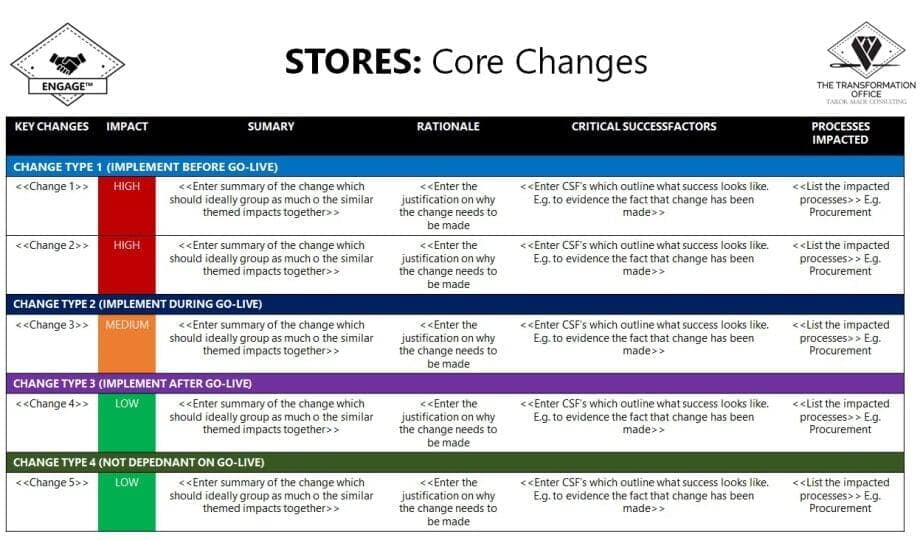
Benefits Map – This section visually shows which change impacts are linked to which benefits lines. This is useful to demonstrate that if the business works on mitigating the respective change then they will help to yield the associated benefit. Note: This is geared towards a larger scale transformation programme with lots of moving parts.
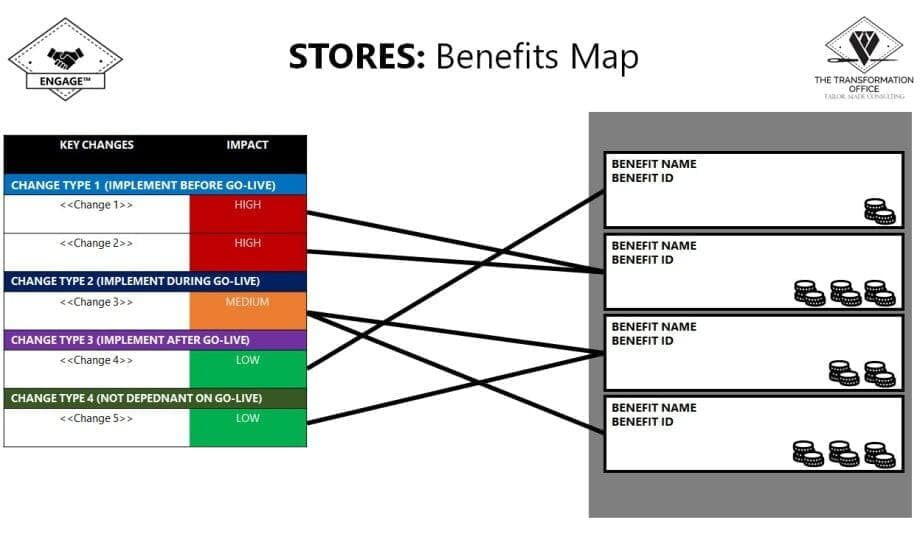
Once you have your Change Impact Assessment you can start to think about getting out into the business to start making them aware of what’s coming. This has no doubt been handled from a generic communication stand point, however, you are now holding the key to unlock your proactive and targeted change initiatives to help the business. In the next three episodes, we’ll be staying put in Stage 3: Change Preparation to demonstrate practical examples of:
- Episode 4 – Change Networks
- Episode 5 – Change Journeys & Plans
- Episode 6 – Control Rooms & Measuring Readiness
Episode 4 - Establishing Change Networks
"You can't do this on your own"
The phrase “analysis paralysis” is probably springing to mind if you’ve been spending days capturing and logging change impacts, reviewing them time and time again and producing change impact assessments. However, at this stage, the Change Team should have a complete holistic view of the change(s) which is going to impact the organisation and what they mean for the various stakeholder groups. Once you have completed the upfront change definition you should have a nagging feeling telling you to stop analysing and start preparing, better still, start or continue engaging with the business. Where do you start? Who’s going to help? Who has already been informed of these changes? How are you going to get parts of the business that aren’t geographically close to you involved?
After reading quite a few Change Management books, the Change Network concept appears multiple times, I think we all know that it’s vital to get the business involved to make change stick. Imagine somebody turning up on your doorstep saying “You’ve got to move house in 2 weeks, trust me it’s a lot better than where you are now, here are the keys and good luck”, you’re probably going to have more questions than answers or worse still you might not believe it and not do anything at all.
If the change definition steps are the “head” of change management, then the change network is the “heart”. Going back to the change framework example I explored in episode one, this primarily sits in Stage 3 – Change Preparation, however, it also straddles into Stage 4 as part of the Change Execution phase. This is simply because without the network you’ll have a limited feedback mechanism to truly understand whether your change plans are going to be effective or not
So, going back to practical applications I’ll demonstrate how I’ve organised and built change networks in the past. I tend to build my networks in a hierarchy of 3 levels as highlighted by the image below but this will completely depend on the size and complexity of the organisation.
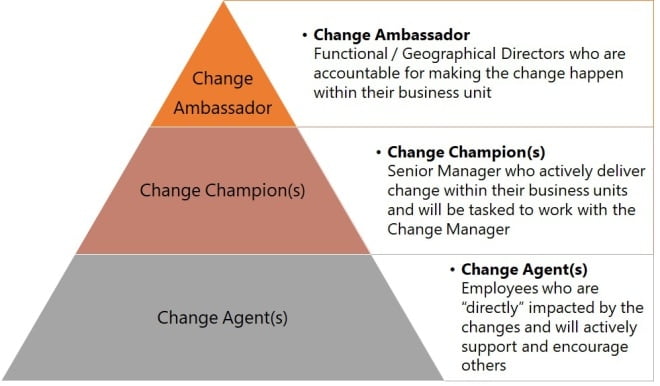
- Change Ambassadors – The good news here is that these people already exist in your organisation as they tend to be the Directors / Heads of Departments. The rule is that typically there should be one Change Ambassador for each business unit who can provide change and leadership support to their teams. Quite simply put, these people are accountable for making the changes happen within their business unit and without their involvement and support your change effort is in for a rocky road. In your plans, you’ll need to invest a lot of time preparing and using the Change Impact Assessment outlined in episode 3, to outline the changes concisely and remember, getting time with senior stakeholders can be tricky so plan wisely.
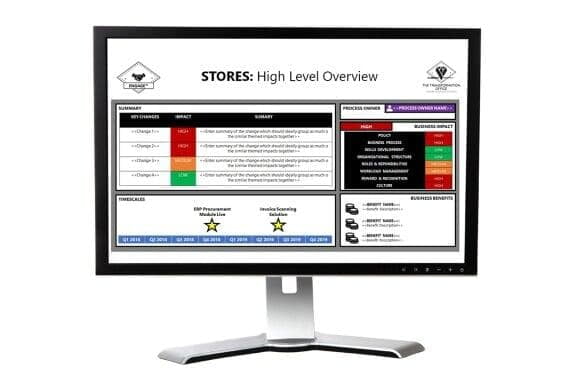
Make sure you have your Change Impact Assessment ready as a stakeholder engagement aid
- Change Champions – These individuals should be identified and formally nominated by the Ambassadors and not the programme team or change manager. This is important because it’s all about ownership of the change; the business needs to be empowered by the Change Ambassadors to be able to first understand the change impacts in detail and more importantly what needs to happen in their business unit to adopt the changes. The Change Champions will be the core active members of the Control Room which is the formal conduit between the programme and business and will provide the barometer on whether change preparations are successful or not. I will cover what control rooms are in much more detail in episode six.
- Change Agents – These will be people who are directly impacted by the change and these individuals would ideally need to be identified by the Change Champions. If the business is quite dispersed, then potentially you may need Change Agents based across all your sites/stores. Their role is to support the Change Champions in creating an environment for change to happen, providing honest feedback and help to relay communications to various colleagues.
Depending on the level of change and how your business is structured then it’s not uncommon to have multiple change networks. For example, an ERP implementation could impact most of the departments in an organisation in different ways so you may need a network per department. It could be that two companies are merging together which have sites internationally so again these networks might need to be created by country, region or even city. Think carefully about how to get the best spread across the organisation. If resources are constrained then using your change impact assessment covers the major/high impacted areas as best as you can.
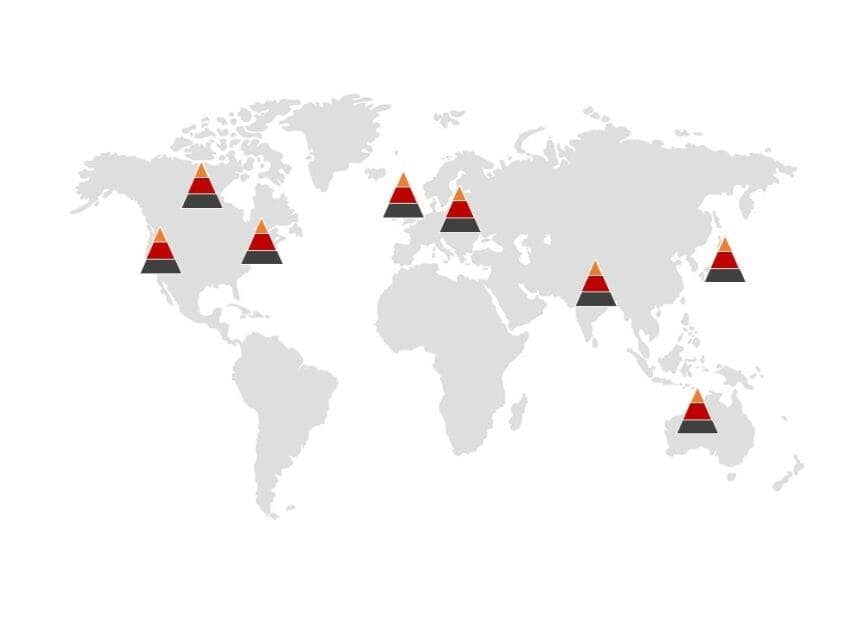
It’s worth noting the amount of time it takes to build these networks, the answer being more time than you think. Ok that answer was quite vague but it depends on several things:
- How many changes are being delivered at any one time?
- How geographically spread the business is (regional, national, international)?
- How complex the organisation is?
Once the network has been established I would recommend that the Change Champions are formally inducted which means investing the programme teams’ time in meeting with them, explaining the goals and deliverables of the projects but more importantly bringing to life those change impacts that you’ve logged earlier.
Episode 5 - Preparing the Change Plans
"Failing to plan is like planning to fail"
Navigating the waters of change management can be a stormy journey and if you don’t have your map to hand or you’re unable to plot your course and plan your route then all you’re likely to achieve is a series of random events which doesn’t even begin to tackle the age-old question “how does this change impact me?”
The Change Plan is your tool which will outline all the necessary activities that need to be completed to execute the change effectively. But before we launch into some examples of change planning I want to cover an important concept which is often missed. There are likely to be several stakeholder groups which are likely to be impacted in different ways and it’s the change teams’ job to map these out so that the activities set are truly going to invoke a positive reaction. For example, if a process is impacting both IT enabled and non-IT enabled colleagues, then the methods used and activities will be different for both.
The picture below highlights that each stakeholder group will need to go on a different change journey for them to be fully prepared for the changes to come.
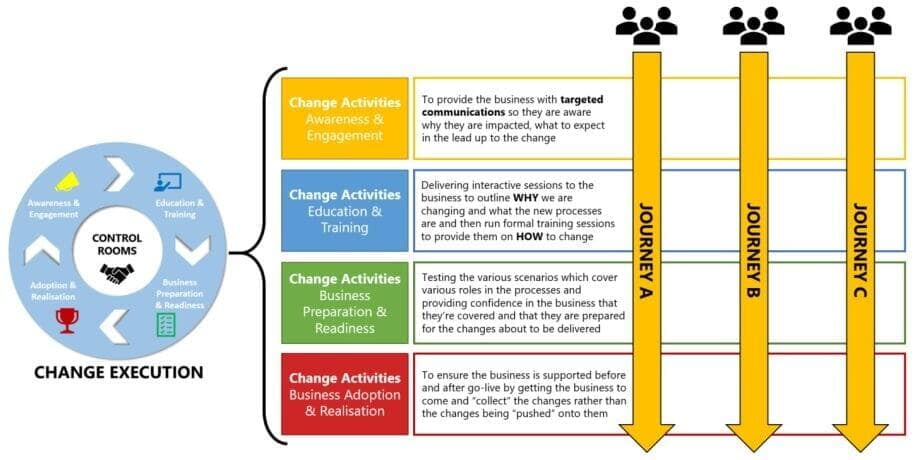
So where do you start with change planning? Well, remember the Change Impacts I talked about in episode 2? My change impact log example included sections to record commentary around awareness & engagement, education & training, business preparation & readiness and business adoption & realisation. You can now analyse the change impact log to extract these potential activities, group them together if necessary and now apply them to your change plans.
Before opening Microsoft Project up and building a Gantt Chart, I want to share a practical example on how to visually build up and map the various change journeys for a bunch of stakeholder groups. In this example an organisations Procure 2 Pay (P2P) processes were being changed due to the implementation of an ERP solution to become standardised and more controlled. You’ll see that the example below has a range of groups from Requesters (Non-ERP) all the way to Vendors / Suppliers. The idea of this template is that each stakeholder group represents a column and if you follow the column from top to bottom through the various core change execution stages then they will be applicable for that group.
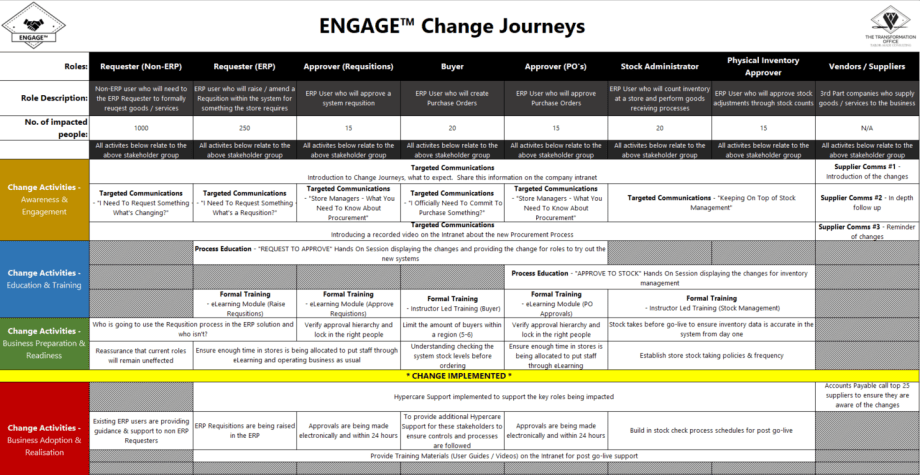
So if we focused on the Buyer group, their change journey would look something like this:
- Awareness & Engagement – The colleagues who have been assigned as Buyers would first receive a targeted communication to outline “what is a change journey” along with other procurement users. This communication will outline what to expect in the upcoming months in terms of communications and sessions available. They would then receive a specific email highlighting the specific changes to them raising Purchase Orders with screen shots of the new solution.
- Education & Training – Further communications will be distributed with a high-level video to demonstrate the new procurement process in action. This is then followed by a hands-on process education session to provide an opportunity for them to try out the changes themselves. Later on, there will be formal instructor led training which will be scheduled right before the go-live periods to help retain knowledge.
- Business Preparation – There is a preparation task which means the organisation needs to try and limit to 6 Buyers within each region to help control and audit the purchasing and also inventory stock counts need to be performed 3 months before go-live to outline and validate the various categories / items are included in the systems and just before go-live to transfer the stock levels.
- Business Adoption – These roles are key to the whole procurement process and there needs to be a focus on stationing Super Users and programme support close to these individuals where possible.
The above template isn’t used to outline the scheduled order of the activities, more a logical mapping of activities to the business stakeholder groups. Once you have the mappings completed internally make sure you engage with your change network to help validate if they are targeted enough, keeping your network included along the way helps them to feel included in the change effort and it will help to own those changes.
Once you have the change journeys all mapped and validated then you can assemble this into a project schedule by working out the dependency order and what it takes to get these activities up and running. These schedules if applicable should be hooked into the overall programme plan so that you have the key milestone dates on when functionality is going to be built, tested and deployed so you can align the timings of your activities.
Change Execution is an iterative process, it’s completely natural that over the course of the change plan you’ll bounce from doing communications one week, business preparation activities and then back to training / education. So, having a chaotic looking change plan is fine, just try and structure the chaos as best as you can and just be prepared that once you’re engaging with your change networks on a regular basis through the Control Room just be prepared to be flexible, this will be my topic for the next episode.
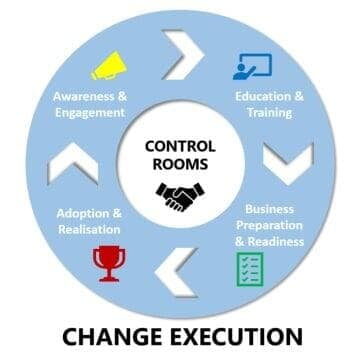
Episode 6 - Measuring Change through Control Rooms
"Creating your own barometer for change"
When it comes to executing change, you can have a well-designed change plan, a change network all established, however without a mechanism to effectively measure change periodically you will never be sure if it’s working, until it’s too late. It’s kind of like having a game of chess where one side of the board is “Your Change Plans” and the other side playing is “The Business Adoption”, you’ve planned and positioned your pieces to close in and ultimately deliver the change plan to full effect and then something happens which means business adoption is at risk, you’re caught on the back-foot and must revise your strategy immediately. I’m not saying the business is the opponent and actively working to defeat you (although sometimes it can feel like that) but you’re faced with so many variables when dealing with organisations, teams, people and culture you must be in the game to listen, respond and make a difference by working with the business.
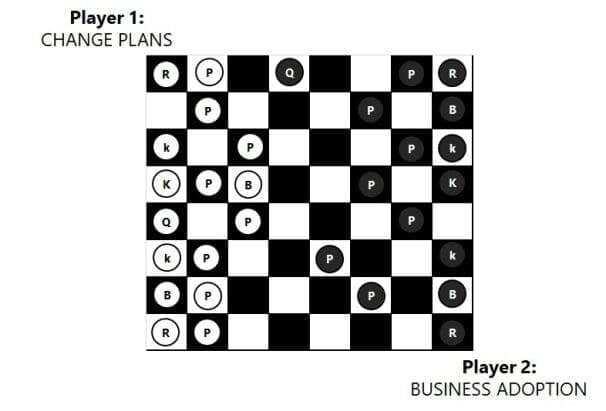
So, the core activities which need to have been completed to even think about measuring change is:
- Having a Change Network established so that you have dedicated individuals you can work with representing the impacted business units
- Beginning to execute your Change Plans so that you have proactive activities to help the business get from “un-aware” to “fully prepared”
Before I discuss how I tackle measuring change, it’s important to understand Control Rooms and how they are the hub of the change execution phase within my change framework, providing feedback on whether your efforts are working or not working.
Control Rooms
A control room is an engagement forum aligned to a business unit so the business understands the deployment of the change initiatives and receives steer and direction from the programme teams to be "change ready"
To break it down further I’ve listed the core objectives of my control rooms on a previous change project.
- Regular forum every fortnight providing a formal link between the Change Programme and the business
- Educate the senior team so they are empowered to drive change in their function
- Regularly review feedback from the business unit back into the programme team
- Review deployment and change plans & approaches
- Discuss readiness checkpoints and criteria to provide overall focus
- Plan business resources to support in readiness activities
- Regularly review Risks, Issues and Actions
So now you’ve defined the governance of what a Control Room is it’s time to start getting attendees. You need to work out who the appropriate people are from the change networks who can commit that time to attend but also to help field and co-ordinate actions on the business side. Once you’ve got your attendees, get the first one booked in and use that to explain the control room concept and outline what the typical agenda will be.
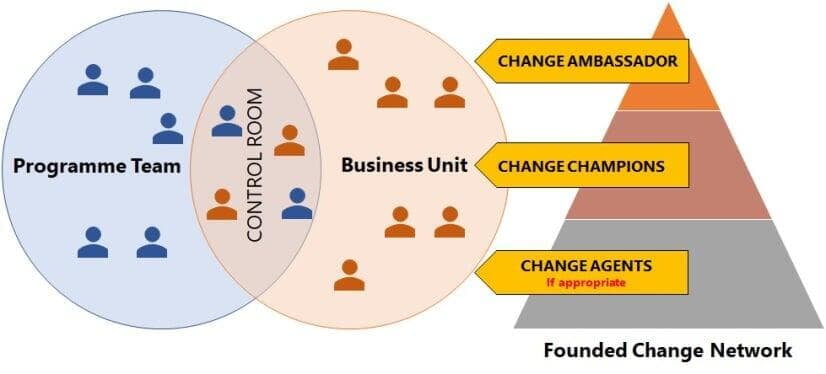
The typical agenda points in a control room can range depending on where you are in the plans and what you need the business to do to be ready for the changes. It’s important that you can “measure change” which means you need tangible milestones to link to. I found it extremely invaluable to have a checkpoint system like the example below, mapped and created before I engaged with my control rooms which helped drive the focus of the meetings but more importantly enabled me to know whether the business unit had passed a checkpoint.
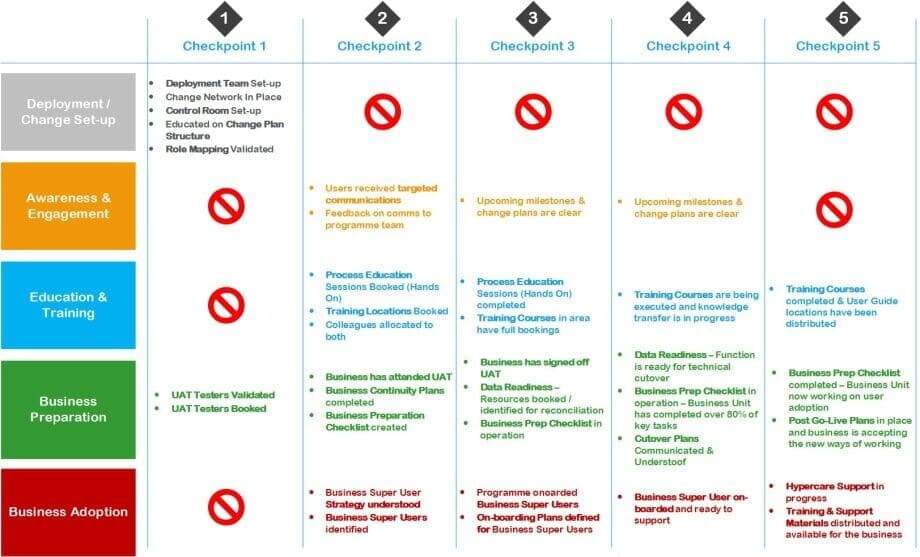
Now you have a defined measurement system you can easily produce charts / visual management for the Programme Managers / Directors stating where each business unit is on their change journey but also more importantly whether they are struggling or falling behind. This is an effective way to get the sponsors more involved with the senior teams to learn and help them to get more engaged with the programme.
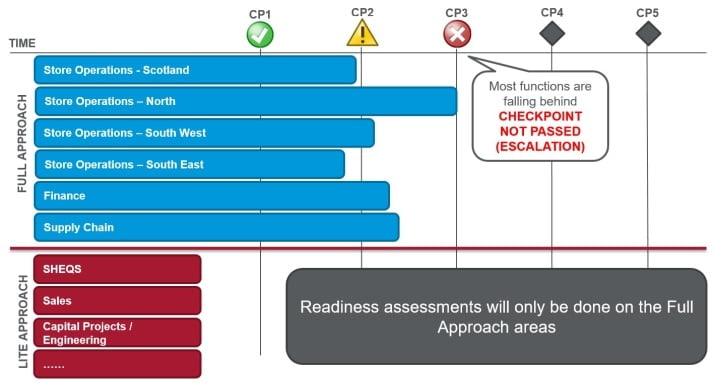
Next time I’ll be diving into some of the examples within a change plan focusing on communications planning, bringing to life a process (day in the life of) and the effectiveness of hands on process education sessions.
Episode 7 - Building Confidence Through Awareness
"Bringing the changes to life"
You’ve managed to get yourself into a good strong position by having defined the change impacts to understand what it means, you’ve built a solid change plan and mapped it to the various stakeholder groups and you’ve built your change networks and established control rooms to regularly measure feedback.
Now I want to take a step back and just focus a little bit on the proactive change activities included in "Awareness & Engagement" and "Education & Training" as part of the ENGAGE™ Change Framework. I’m not going to go deep into communications strategies and training approaches because generally there is a lot of content around those topics. Instead I’m going to share a few practical tools and tips within this stage of the framework which hopefully you will find useful.
You can edit text on your website by double clicking on a text box on your website. Alternatively, when you select a text box a settings menu will appear. your website by double clicking on a text box on your website. Alternatively, when you select a text box
Communication Channels
Before you start writing your first official communications as outlined by your change plans it’s wise to start to capture all of the available channels which are at your disposal. It’s always surprising how many there actually are and whether they are formal or informal.
The template below highlights a way of capturing the channels:
- Channel – The name of the channel
- Channel Description – An outline of what the channel is
- Channel Utilisation – Overview of why this channel is in use
- Frequency – How often the channel is used to publish comms
- Media – Whether the comms are physical or digital
- Audience – Which stakeholder groups in the business is this channel for
- Channel Owner – Who in the business owns the channel and would be your contact for to assist pushing comms through
- Comms Distributor – Who in the business physically distributes the comms through the channel
- Direction (Push or Pull) – Is this communication channel a push only, pull only or both
- Feedback Mechanism – What is the feedback mechanism if applicable
- Effectiveness Rating – Your rating on whether the channel will be effective for your programme of change
- Effort Rating – Your rating on the effort involved in publishing through the channel
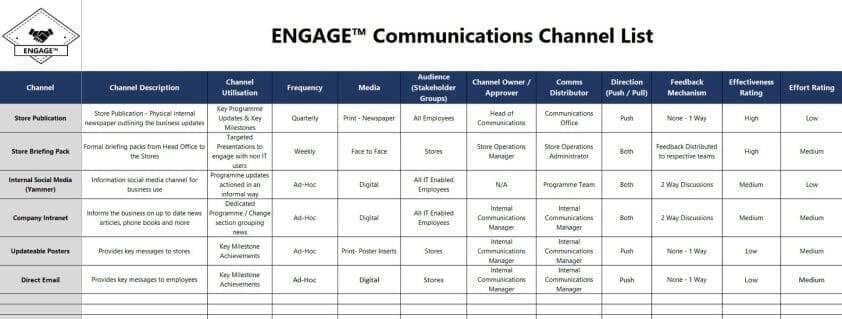
You may find that during your analysis of the communications channels, you have gaps in reaching key impacted stakeholder groups; the answer here is that you may need to create new channels. For example, if you have non-IT enabled employees then emailing communications isn’t ever going to reach them, however providing a poster in the lunch room with inserts printed out each month could work.
Day In The Life Of (DILO)
One of my favourite tools in business engagement which borders on education is the “Day In The Life Of”. This is a visual aid which focuses on one or more stakeholder group(s) which is impacted by a change and then highlights what the new ways of working will be.
In the example below, we have a the Procure to Pay scenario on stock purchases over £50K, these visuals outline how the various roles will interact with each other and across the scenario so that end users can start to understand the changes that are coming up. It’s important not to stick to generic scenarios and to utilise your change network to understand the key scenarios that they would like to bring to life. The Day In the Life Of visuals can then be used in a variety of communications such as emails or posters printed out on department walls.
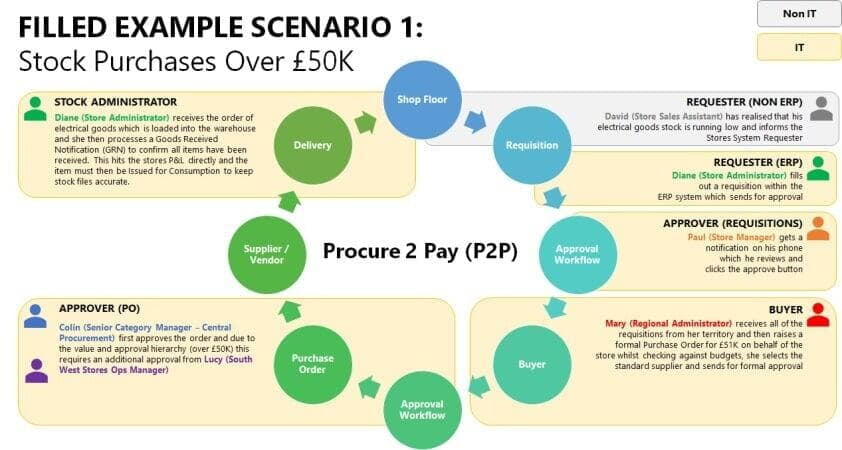
Process Education
To round off this article I wanted to mention the importance of Process Education in the engagement and training process. Not that I agree with change activities being delivered in a waterfall methodology in all cases but it makes sense that Process Education fits between the first round of communications providing awareness to the business and their formal training.

Process Education is essentially a physical workshop / session where impacted users attend to cover the following points:
- The business can learn more about the upcoming changes from the programme team following on from the initial communications
- The business can get their hands on the new process or system. IMPORTANT: Depending on the change it’s critical that the business can “try before they buy” as then you are covering a variety of learning styles (visual, auditory, read/write, kinaesthetic)
- Ask questions / provide feedback to the change team and programme team.
There’s no magic wand or secret here just understand your audience, understand your available channels, create new channels if needed, listen to the business and revise your approach if necessary.
Episode 8 - Business Preparation Checklists
"Creating and executing the recipe for change"
In this article, I’m going to explore the change activities which fall within “Business Preparation & Readiness” as part of ENGAGE™ Change Framework. These activities focus primarily about preparing the individual, team or organisation for the changes ahead by physically doing things. Technically performing awareness or education type activities is preparation however, I like to think of this stage being more of the ‘to do’ list of the business that they need to complete before any change is implemented.
Back in the second episode I discussed the importance of change impacts and how we can identify its change impact type to be managed before, during or after cutover / go-live. These business preparation type change impacts should have been reviewed and added to the change journeys also outlined in episode five so you should have the building blocks to start helping the business help themselves.
Using your control rooms as discussed in episode six, is the change team’s mechanism to first creating a checklist for the business to follow but also more importantly ensuring that it is being followed and reported back to the programme or sponsors.
The practical example below highlights how I’ve created a checklist on a previous transformation programme where an Enterprise Resource Planning (ERP) system was being implemented to multiple parts of the business at the same time. Once the key information is analysed then those tasks can be logged on the checklist to capture the following information:
- What does it relate to? PROCESS - Is this task related to an end to end process that's changing (e.g. Procure to Pay)
- What is the activity? TITLE - What is the task that the business needs to resolve
- What do we need to do? DESCRIPTION - Further detail on what the business needs to resolve & why
- When do we need to do it by? DEADLINE - In accordance to your change plan when do these activities need to be completed by?
- Which core impacted business units does the activity related to? - Not all preparation tasks will relate to all business units so having these mapped will help you to be able to focus on what a specific business unit needs to do whilst keeping all of the activities together and visual
- Status of preparation activities? - To highlight whether the business unit has started or completed a task monitored through control rooms.
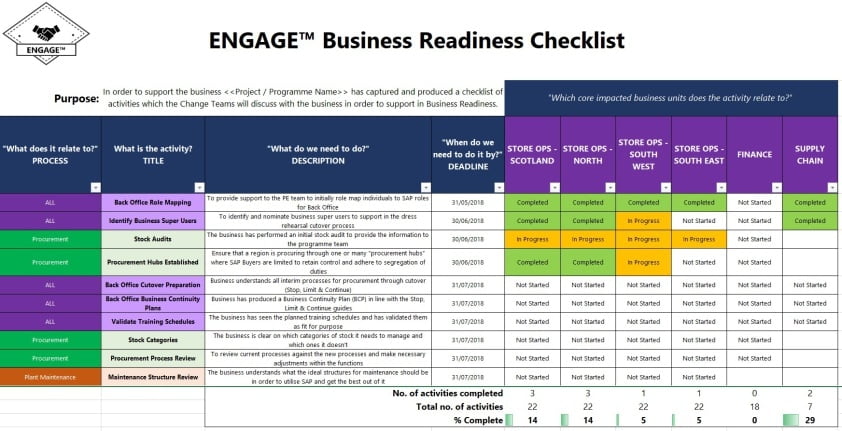
The checklist truly sits in the heart of the control room process where the initial list of tasks is set from the change plans, the change team is meeting regularly with the business unit identifying what needs to happen and reporting progress back into the programme. This mechanism can also be used to link the programme teams’ requests on the business which can sometimes become a bit ad-hoc depending on the size of the changes. The benefits of using preparation checklists are:
- Tangible measurement on how prepared each business unit is for go-live
- Easily compare against other divisions to help motivate them
- Easily filter and hide information not relevant to a business unit
- Visualisation to physically see % completion
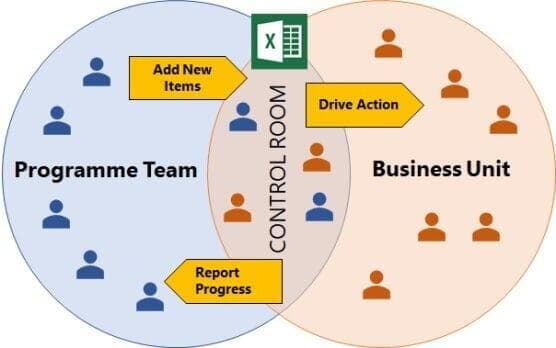
Episode 9 - Business Adoption & Support
"Implement change is the journey and sustaining change is the destination"
As we draw this series to a close I wanted to focus the final article in The Practical Change Manager all around the final change activities in "Change Adoption & Realisation". The first thing to mention is that there isn’t a one stop activity which will guarantee business adoption, obviously. If your change plan was well thought out, and pulled together proactive activities based on the change impacts captured at the start, then you should be on the road to success. Even then, the unexpected can occur once the change has been implemented and the business is grabbling with the new ways of working. These are a few of the techniques that I lean towards during this crucial time.
Build Effective Hypercare Support
If you can imagine you’ve just bought a new car and the salesperson has left you with the keys to drive off the forecourt, you know how to drive but it’s going to take you longer to adjust to the new vehicle and its components. How do you set the seat position correctly? How do you move the mirrors? Where is the button to start the engine? Seriously, how do I get my favourite DAB radio stations back?
Hypercare support needs careful attention and time to prepare how you’re going to build the processes and resource it. As per the example diagram below you’ll need think about the following steps:

- Analyse - What is required to give the business the additional support, is it remote people sitting in the stores during go-live or a manned help desk taking calls, what would be needed to make this happen?
- Design / Preparation – Once the model has been decided then how will the processes work in conjunction with the company’s existing support services. The business needs to be clear on what to do, who to contact during these turbulent times.
- Final Preparation – Ensuring that the processes are locked down, items are procured and everyone involved knows where they need to be and what they need to do.
- Hypercare Support – Providing the front-line support once the go-live milestone has been achieved
- Transition to Business as Usual Support – The project team can’t run hypercare support forever and therefore gradually merging with the company’s existing support process is critical to avoid confusion but also to make sure the knowledge is transferred accordingly.
Maintain Your Control Rooms
It might be tempting to think that once the change has been implemented then effectively the job is done, far from it. Back in episode six I talked about the importance of control rooms and this is even more true during this turbulent time. This is your time to make sure you as the Change Manager are partnered with the business teams at the coalface, listening to the feedback and providing solutions to any issues that are occurring.
Benefits Realisation & Feedback
I’m not going to dive in deep around Benefits Management as this is a broad subject which could be its own series of articles. I wanted to mention this as your change initiative or project should have business benefits associated and owned by key business roles within the organisation. Benefits realisation is a great indication on whether change is actively working or not. For example, if a Sales Order team currently processes 300 orders a month but after some efficiency changes they should be able to process 500 orders a month, then the benefits measurement process can be used to track and feedback to the business. These measurements can aid the business to understand whether more work is required and what potential blockers are preventing the benefits from being realised.
Thank you for reading The Practical Change Manager series, for more information around ENGAGE™ please check out our Products & Services page
